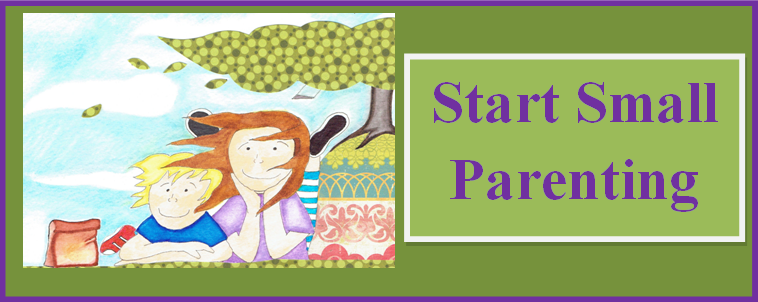
Help! My child won’t listen.
My child refuses to do what I ask.
I have to say things over and over and still she refuses.
Many parents are in the habit of repetition when they ask their child to make a behavior change. Hence, the children may perceive that their parents are “demanding” or “nag all the time.”
What to do when even the sound of your own voice drives you crazy? How can you help our child not only listen to your voice but respond as well?
Crossing the Street
We can look to the dangers of the street for help.

We all know to teach Stop, Look, and Listen to our children, especially in dangerous situations, like in parking lots or crossing the street. We teach the child to come to a complete stop, look both ways, and listen for any car noises before crossing the street.
I remember introducing these important concepts to my son before he was fully developmentally ready–when he was still holding my hand and I was reminding him of each step as we did it. By the time he was ready to cross the street on his own, these three concepts were ingrained through repetition and consistency.
Such a useful tool can be used in other areas of parenting – any time we need our child to listen to our voice. We can teach our child to stop when they hear our voice. We then teach them to look right at us. This way we know we have their full attention when we ask our child to listen to our words.
At the Grocery Store
Let’s look at a visit to the grocery store. This is a great place to observe parenting.
A father is pushing the cart along the aisles, looking for aluminum foil, when suddenly he realizes that he has turned down the toy aisle of the grocery store. His 3 year old daughter grabs something off the shelf. He sees that it is the latest craze doll. It is way over-priced due to it’s popularity.
“Put back the doll,” he says. The girl grips the doll and shakes her head. “No way. I said, put it back on the shelf. Did you hear me? You are not listening. Put it back NOW!” She runs away from him with the doll clutched to her chest.
Many of us have been there, repeating and nagging with little effect. The child often learns to tune out the parent until a certain tone or decibel is reached.
The parents’ repeated act of asking and the child’s seeming defiance of the request can lead to much frustration which can often escalate to anger when the child will not listen. Each experience builds on the rest as the child learns to ignore their parent’s voice. This can occur so often that eventually it becomes the norm.
The Cons of Counting
Some parents use counting to get their child to pay attention and behave a certain way. “Sylvia, put that doll back. Do it now. I’m going to count to 3. You know what happens if I get that far. Okay, 1 . . . 2 . . .3 . . ” What’s happening here is that the parent has taught the child to obey by a certain count. There is a threat at the end of the count.
This may produce a desired outcome but at what cost? First, The child reacts to the threat of counting not because it is the responsible action, but because of what might come at the end of the count. The implied threat falls on the punishment scale. Dad is more powerful and the child had better do what he says or else. Second, the climate is one of disrespect. For parent and child. Third, the child has learned NOT to listen to the father’s voice the first time. She has learned to disregard what Dad is requesting until he finishes the count.
Why not help the child to perform the expected behavior the first time, instead? This practice will help.
Stop, Look, and Listen
It makes parents mad when their child won’t listen. The first step before you teach your child anything is to Adjust Your View. The parent’s work is to reframe this issue: It’s a Good Problem. In fact, it’s a GREAT problem. The child is showing that she hasn’t learned to listen and respond to her parent’s voice. This is what her parents can help her learn. But… how do you teach them to listen?
There are three steps:
1. Your child is to STOP when they hear your voice.
2. They are to LOOK right at you. This way you know you have your child’s full attention.
3. They are to LISTEN to your words.
Just as you practice these steps every time you cross the street, it’s important to instill this for every day behavior.
This is most easily taught to young children, but many older children have not learned it. Remedial as it sounds, this is one of the most important behaviors a child can learn at any age.
The rewards of having your child listen to your voice (the first time) are increased self-regulation, better communication, as well as less frustration for both child and parent.
Back at the Store
Let’s try a Do-Over with the grocery store experience.
Physical Intervention and Distraction. Dad sees the doll and knows it is not something they will get right now. He is quick, almost anticipating the behavior and provides a physical intervention. Quickly, yet gently, Dad takes the doll from Sylvia and places it back on the shelf. “Oopsie, that stays on the shelf.” Then a quick distraction, such as,“Let’s go find the bananas. I need six of them. Help me count to six.”
But what if Dad doesn’t think of either of these actions? Or the child has tightly gripped the doll in anticipation of a “no” from her father.
Here’s how Dad can use Stop Look and Listen. They have been practicing this together at home.
“Sylvia, the doll goes on the shelf.” She grips the doll to her chest and starts to run down the aisle. Dad says, “Stop.” Sylvia stops. Dad says, “Look at me.” Child looks. If she doesn’t look, Dad is a detective to determine if she is listening. Dad says, “You really want that doll. We aren’t shopping for dolls today. Let’s put this one on our wish list. Here, help me draw the picture so we remember.” Dad takes out a small pad and a pencil and draws a stick figure of the doll. Sylvia nods. From experience, she knows her father will get back to the list soon and they’ll pick something from it that they both agree on. “Okay, Sylvia, do you want to put the doll back yourself or do it together?” She puts the doll back.
This may sound too good to believe in families where the child ignores the parent’s request or is unable to do what is asked. Remember, this is a good problem. The child hasn’t learned to do this yet.
In teaching your child the new skill of listening to your voice, it’s key to have patience. It’s also important to have a plan. In this case, it could be a pre-meditated shopping trip where the child has a chance to practice a Necessary No. The parent can be sure from experience that the child will ask for something that is a no. The parent lets the child know ahead of time what is the respectful on-track behavior, how the parent will help the child, and what will happen if there is off-track behavior (i.e. leave the store, child sits with other parent, etc.) The child’s world stops but not the parent’s whenever possible.
Your Curious Detective skills will help determine your actions. Since we look at starting small, it’s not too early to introduce some basic ideas before the child is ready to actually do what is asked. Output does not always match input.
Setting the Table
Mom is making dinner. Her two children, 3 and 5, are drawing. Mom wants them to help set the dinner table. The way she has gotten them to respond is to count to a number and provide a threat at the end of the count. (For example, “I’m going to count to 5. If you don’t come when you hear 5, we’re not going to the zoo tomorrow.”) This time, she will try something different.
Mom: From now on, I want you to listen to my voice on the FIRST TIME.
Kids look up puzzled.
Mom: I won’t be counting anymore. I’ll tell you one time what I need to tell you.
The older childl: So, if we don’t listen, we’ll get stuff taken away sooner?
Mom: If you don’t respond to my voice, we’ve got a bigger problem of not respecting each other. We might need to stay home from extra activities for a few days so we can practice as a family.
Both kids: Oh, no. I don’t want to miss going to the zoo tomorrow.
Mom: Okay, let’s practice now. In 15 minutes, I’ll ask you to STOP what you are doing. I want you to LOOK at me. Then LISTEN to my voice. I’ll ask you to come help set the table. You’ll both respond to my voice on the first time.
Mom sets the timer. Fast forward. In 15 minutes, she asks them to come set the table and they do.
No one has been threatened. There is no punishment. No yelling, cajoling. No tears.
There is an important distinction to be made between this parent’s past scenario of counting and the current experience with Stop Look and Listen. In both, the zoo visit would be postponed. In the counting/threat instance, the parent imposes her will and decides the consequence (no zoo) in order to instill the behavior. In the practicing example, the children are in charge of what happens next. They are encouraged to respond from the inside-out, rather than relying on the parent to enforce the behavior through an external punishment.
In the 3R’s scenario, there are three main elements:
1. Thematic: the parent provides a thematic teaching opportunity (Stop Look and Listen) which once learned, can be applied to many situations.
2. Internal learning: The children are in charge of whether they listen the first time. They are stopping their own world (no zoo) by their actions if they don’t or aren’t able to listen. There is an internal experience.
3. Practice: Taking time to practice the new skill of listening/responding instead of going to the zoo allows them a chance to really learn it. The parent knows this is developmentally within their grasp. The children will be eligible for the zoo or a similar event once they have practiced this skill. (They may not be able to fully display the skill, but practice is the first place to start when learning anything new.)
Bringing in Guerrilla Lovefare
Many times when you use this practice, you will be asking your child to make a behavior change, often away from their preferred direction. This can be uncomfortable or cause a strong reaction in a child, which can often happen when change is asked. In order to keep this practice fresh, give direction to do something fun or pleasurable together. Surprise your child with something creative or unexpected.
For example:
Mom: Mary, stop what you’re doing. (Mary stops splashing in the sink.) Look at me. (Mary turns her head and their eyes meet.) Let’s get on our boots and go splash in the puddles.
Mary is off her step-tool in a nano-second and at the front door getting her boots on. Listening accomplished.
Self-Control Exercises
Here are some reinforcement activities you can try at home. For younger children these games give your child a chance to practice what you are trying to teach, make a connection with you, and practice self-regulation. Instead of the nagging loop that frustrates both parent and child, this encourages respectful exchanges and increased focus.
Eye Palming. For some children, learning to STOP when they hear your voice is difficult. This variation helps the child practice the act of stopping and focusing.
1. Rub your hands together until they feel warm.
2. Close your eyes and cover them lightly with your cupped palms. Avoid applying pressure right to your eyeballs.
3. Your nose should not be covered.
4. Make sure no light rays can enter your eyes though gaps between your fingers or the edges of your palms and nose. You may still see other lingering traces of colors.
5. Take deep breaths slowly and evenly while thinking of some happy incident, or visualize a distant scene.
6. Imagine deep blackness and focus on it. After you see nothing but blackness, remove your palms from your eyes. Repeat the palming for 3 minutes or more.
Watch Me. This game works best when children have reached a verbal stage.
1. Sit across from your child. Both fold your hands in your lap or rest them on the knees. (This helps build self-control.)
2. Instruct the child to watch your face.
3. Count silently, but move your mouth.
4. When you stop counting, see if they can tell you the last number.
Pendulum. Same as above but use an object dangling on a string or necklace. Have them keep their eyes on the object and count how many times it swings back and forth.
Moving Eye Contact. This is a second step of the Watch Me game. Make eye contact. Have your child remain seated. As you get up and move around the room, see if they can keep eye contact with you the whole time. Not only does this help with tracking, it’s a great way to reinforce the need for them to pay attention to you.
Movement Game. Now that you really have your child’s attention, you can reinforce listening to your voice on the first time with a fun practice game.
1. Parent sits. Child stands.
2. Give your child silly instructions which they do on the first time. Stick out your tongue. Touch your ear with your toe. Bring me an apple. Hop around the room.
3. Stop – Give your child a movement directive (skip, jump, tip-toe, etc.) then say Stop and they freeze.
4. When you say Look, they move only their head to look at you.
5. Listen – When you say Listen, give your child a new movement to do.
Freeze Songs
1. Play a movement song that has directions that you and your child can follow together. As they practice the directions (Freeze, walk, hop, etc.) they are practicing neuromuscular impulse control.
2. Two great one are by the artists, Greg and Steve: The Freeze or Listen and Move
Tips for Stop Look and Listen
- If the child feels that they are too old or above the exercises, let them know that people of any age can benefit from focus exercises. You can also remind them it is their job to show you how they have learned to listen and respond to your voice. If not, it’s a good opportunity for a Do-Over.
- Is your child still having trouble with this one or resisting it? You can remind them that they live in a respectful household and that you are helping them learn respectful behaviors. Listen to Your Voice on the First Time is the A before they can partake in B which are privileges: going to the zoo, hanging out with friends, watching TV, playing ball, building a fort, etc. Reinforce this during your family meetings.
- Be a keen observer as to how your child responds to your voice. Do you repeatedly need to say their name or repeat instructions? Are they in the habit of ignoring your voice or your instruction? Have frustrations ever escalated around children not listening? Give credit for any improvement. Your positive voice is a powerful teaching instrument.
Stop, Look, and Listen is a parenting staple in our household. The rewards of having your child listen to your voice (the first time) are better communication, less frustration for both child and parent, and a deeper emotional connection.
Start when they are small to lay the groundwork now for a respectful, responsible, reliable family.


One Response to “Stop. Look. And Listen. Not Just For the Street.”